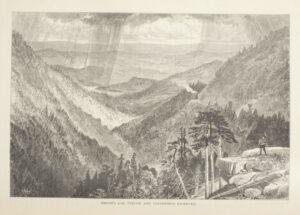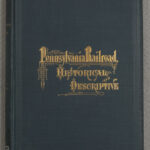The British invention of the steam locomotive in the late 18th Century was not only an essential stimulus of the Industrial Revolution; it was the single most important practical application of steam technology ever. American engineers were well aware of these developments and for decades volleyed new ideas across the Atlantic with their European counterparts. By the 1840s, the industry was booming, and American railways spread from eastern seaboard to western frontier.
It is little surprise that the dominant American railroad of the 19th and early 20th Centuries was headquartered in Pennsylvania, an early nexus of industrial rail transport. Founded in 1846, 36 years after America’s first railroad, the Leiper, made its first horse-drawn trip outside of Philadelphia, the Pennsylvania Railroad was originally chartered by the state to connect Harrisburg with Pittsburgh by steam locomotive. It did just that, and went on to control over 10,000 miles of railway line, tripling the amount of traffic of other railroads of comparable length. It eventually became the largest publicly traded company in the world.
Sipes’ book, as its title implies, presents a  comprehensive view of railroading, from excavation calculations and company expenditures to florid descriptions of scenic vistas, quaint depots, and the romance of the railroad journey. Published just six years after the driving of the golden spike at Promontory Summit, Utah – the completion of the first transcontinental railroad – it is a snapshot of a restless industry in motion. Its extensive engravings, depicting the railroad in urban and rural settings, remain important today for their faithful rendering of train depots and city scenes long since demolished or permanently altered. Most affecting, perhaps, are the panoramic views of train and tracks nestled into an enveloping, still-wild American landscape. They both subtly hint at the insistent and permanent penetration of industry into wilderness, and belie the enormous undertaking that made such views possible: the dynamiting of mountains, the bridging of treacherous bodies of water, and the loss of human life.
comprehensive view of railroading, from excavation calculations and company expenditures to florid descriptions of scenic vistas, quaint depots, and the romance of the railroad journey. Published just six years after the driving of the golden spike at Promontory Summit, Utah – the completion of the first transcontinental railroad – it is a snapshot of a restless industry in motion. Its extensive engravings, depicting the railroad in urban and rural settings, remain important today for their faithful rendering of train depots and city scenes long since demolished or permanently altered. Most affecting, perhaps, are the panoramic views of train and tracks nestled into an enveloping, still-wild American landscape. They both subtly hint at the insistent and permanent penetration of industry into wilderness, and belie the enormous undertaking that made such views possible: the dynamiting of mountains, the bridging of treacherous bodies of water, and the loss of human life.


